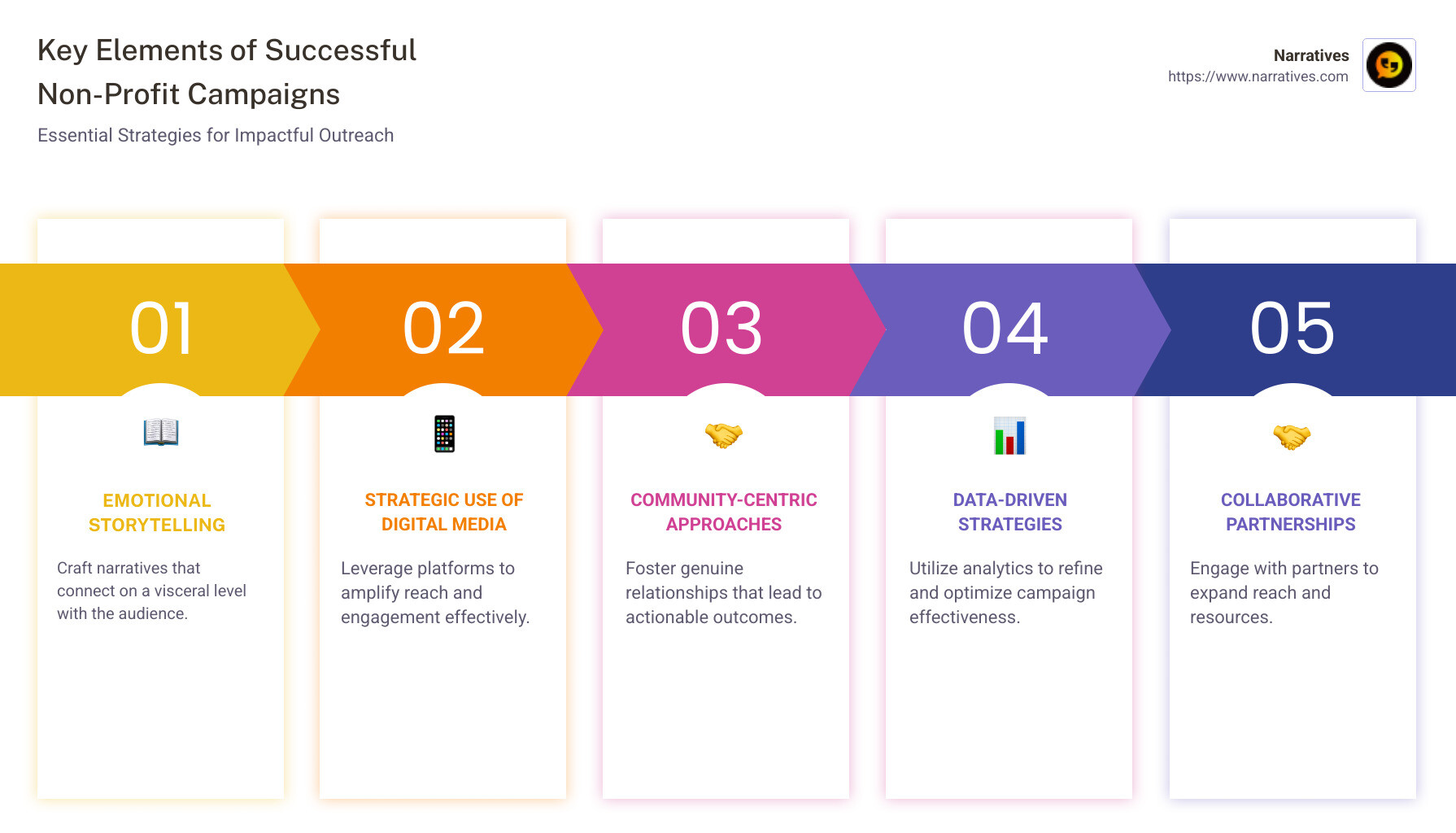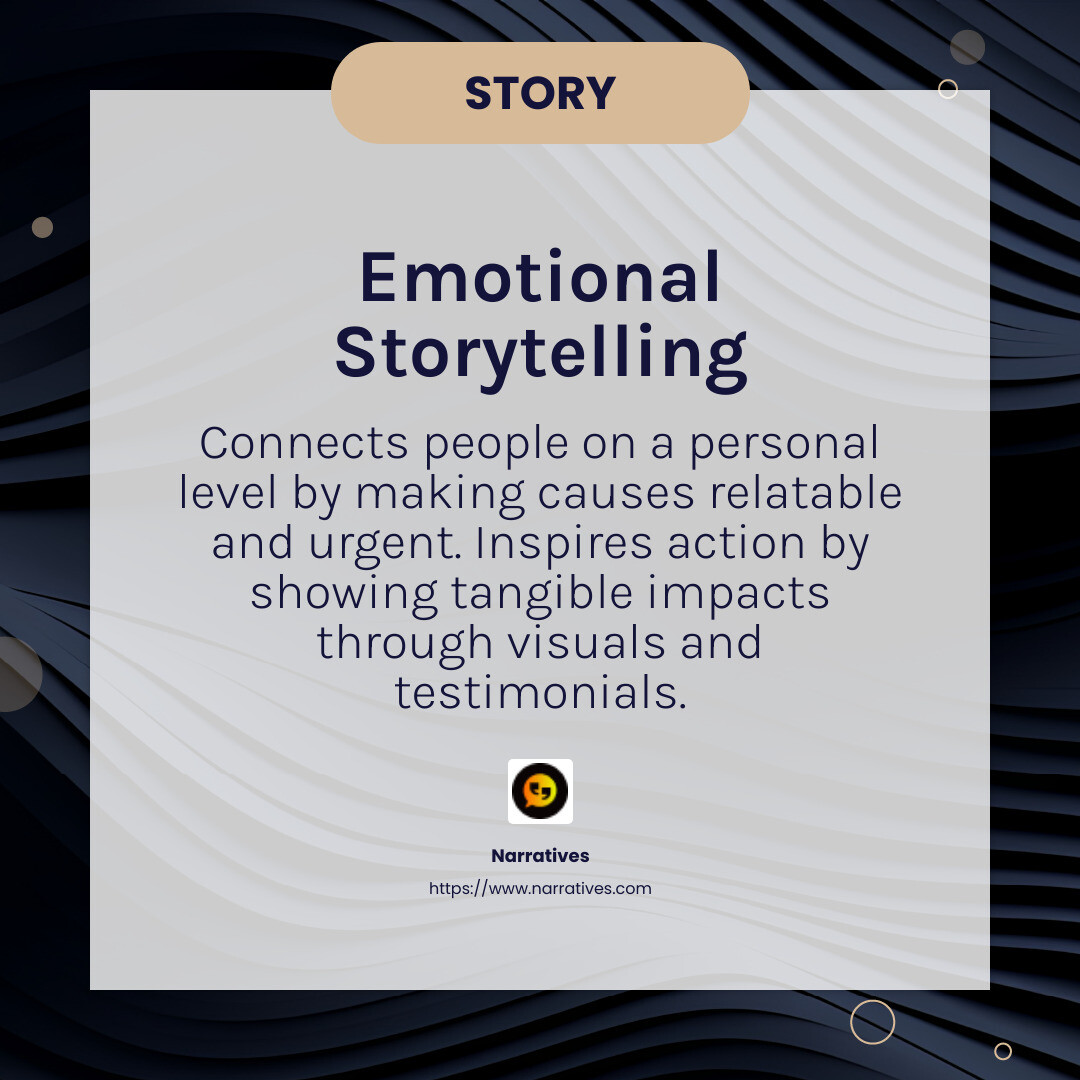Winning Hearts: A Look at Successful Non-Profit Campaigns

Successful non-profit campaigns capture hearts and minds with storytelling, engage supporters through digital media, and drive measurable impact. In this exploration, we'll look at winning strategies behind notable campaigns that excel in these areas:
- Emotional Storytelling: Crafting narratives that connect on a visceral level.
- Strategic Use of Digital Media: Leveraging platforms to amplify reach and engagement.
- Community-Centric Approaches: Fostering genuine relationships that lead to action.
In today's digital world, non-profits are challenged to blend purpose with powerful storytelling. The most successful are those that use innovative digital strategies to inspire and mobilize. From using the potential of social media to creating immersive experiences, these campaigns are more than just stories—they are movements that drive change.

Understanding Successful Non-Profit Campaigns
Successful non-profit campaigns are more than just fundraising efforts; they are powerful movements that create lasting change. Let's explore the key elements that make these campaigns resonate with audiences and achieve their goals.
Fundraising Strategies
At the heart of any successful non-profit campaign is a well-planned fundraising strategy. These strategies vary in form and scale, from annual campaigns to capital campaigns aimed at specific goals. For instance, the ALS Ice Bucket Challenge is a stellar example of a viral fundraising effort that raised over $220 million for ALS research. It combined a fun, participatory challenge with the power of social media to engage a global audience.
Building Awareness
Raising awareness is crucial for non-profits to spread their message and reach potential supporters. Campaigns like St. Jude’s Thanks and Giving leverage partnerships with major retailers and celebrity ambassadors to amplify their reach. By engaging customers at the point of sale and through media channels, they effectively increase visibility and encourage donations.
Community Impact
The ultimate goal of any non-profit campaign is to make a tangible impact in communities. This is achieved by not only raising funds but also by mobilizing people to take action. Feeding America’s #EndHungerNow campaign is a great example, delivering over 5 million meals through a combination of social media challenges and local food bank partnerships. By turning small actions into collective impact, they demonstrate how community-driven efforts can lead to significant change.
Successful non-profit campaigns use these elements to not only tell compelling stories but also to build strong, action-oriented communities. They are not just about raising money; they are about making a difference.
5 Examples of Successful Non-Profit Campaigns
Breast Cancer Now, CoppaFeel, Asda
Breast Cancer Now and CoppaFeel! teamed up with Asda to create the Real Self Checkout campaign. This initiative cleverly used breast cancer awareness to reach a broad audience through everyday shopping experiences. The campaign featured barcodes on till receipts and stickers on Asda products, prompting customers to check their bodies for lumps and bumps.
The simplicity of this self-checkout campaign made it highly effective. By integrating the message into routine shopping, it made participation effortless and impactful. The collaboration with a trusted retailer like Asda added credibility, making it easier for people to engage with the cause.
Suicide Co: The Words Unspoken
SuicideCo’s Words Unspoken campaign tackled the stigma surrounding mental health by using a bold approach. It featured billboards displaying suicide notes, aiming to spark conversations and encourage openness about mental health struggles. This daring strategy generated widespread media coverage and increased calls to mental health helplines.
While controversial, the campaign succeeded in its primary goal: to destigmatize mental health issues and encourage people to talk about their feelings. By challenging societal norms, it brought much-needed attention to a critical issue.
The British Tinnitus Association: The Sound of Science
The British Tinnitus Association launched The Sound of Science to promote tinnitus awareness and gather data for their biobank project. Despite launching during a pandemic-dominated news cycle, the campaign exceeded expectations by signing up 3,500 participants in just one week, far surpassing their initial goal.
This campaign highlighted the power of targeted outreach and the importance of giving a voice to those affected by tinnitus. The resulting data not only supported research but also raised awareness about the mental health impact of tinnitus.
ALS Ice Bucket Challenge
The ALS Ice Bucket Challenge is a prime example of a viral campaign that took social media by storm. Participants were challenged to dump a bucket of ice water over their heads, share the video, and nominate others to do the same or donate to ALS research.
This campaign raised over $220 million and significantly increased ALS research funding. Its success lay in its fun, shareable nature, which encouraged widespread participation and awareness, proving the immense power of social media in modern fundraising.
St. Jude’s Thanks and Giving Campaign
St. Jude’s Thanks and Giving Campaign effectively combines childhood cancer awareness with retail partnerships and celebrity ambassadors. By collaborating with major retailers and celebrities, such as Sofia Vergara and Chip and Joanna Gaines, the campaign reaches a broad audience, encouraging donations during the holiday season.
The campaign's strength lies in its emotional storytelling and strategic partnerships, which amplify its reach and impact. By connecting with consumers at the point of sale and through media channels, it raises significant funds for childhood cancer research while spreading hope and awareness.
These successful non-profit campaigns demonstrate the diverse strategies organizations use to engage audiences and create meaningful change. Whether through clever retail partnerships or viral social media challenges, they show that creativity and collaboration are key to making an impact.
Key Elements of Successful Non-Profit Campaigns
Creating a successful non-profit campaign requires a mix of emotional storytelling, strategic partnerships, and effective social media engagement. Let's explore these key elements.
Emotional Storytelling
At the heart of any impactful campaign is a compelling story. Emotional storytelling connects with people on a personal level, making the cause relatable and urgent. For example, the St. Jude’s Thanks and Giving Campaign uses heartfelt stories of children battling cancer, paired with visuals and testimonials, to create a powerful emotional connection. This approach not only raises awareness but also inspires action by showing the tangible impact of donations.

Strategic Partnerships
Forming partnerships can significantly amplify a campaign's reach and credibility. Collaborations with well-known brands or influencers can introduce the cause to new audiences and lend authority to the message. The Breast Cancer Now, CoppaFeel, and Asda campaign is a perfect example. By teaming up with a trusted retailer, the campaign seamlessly integrated its message into everyday shopping experiences, making it more accessible and impactful.
Social Media Engagement
Social media is a powerful tool for spreading awareness and encouraging participation. The ALS Ice Bucket Challenge exemplifies how a simple yet engaging social media campaign can go viral, raising over $220 million for ALS research. By leveraging platforms like Facebook and Instagram, non-profits can reach a global audience, encourage user-generated content, and foster a sense of community around their cause.
Successful non-profit campaigns harness these elements to not only spread their message but also to drive real change. By focusing on emotional storytelling, forging strategic partnerships, and maximizing social media engagement, organizations can create campaigns that resonate deeply and inspire action.
Frequently Asked Questions about Successful Non-Profit Campaigns
What makes a non-profit campaign successful?
A successful non-profit campaign is one that effectively combines strategic messaging, emotional impact, and execution to achieve tangible results. Here are the key factors:
Clear Goals: Define what you want to achieve, whether it's raising funds, increasing awareness, or driving volunteer engagement.
Compelling Storytelling: Emotional narratives that connect with audiences on a personal level. For instance, the ALS Ice Bucket Challenge succeeded because it was simple, fun, and emotionally engaging.
Multi-Channel Approach: Reach your audience where they are. Use email, social media, and traditional media to spread your message. The It Gets Better Project effectively used TikTok and other platforms to amplify its message.
Engaging Visuals: Use visuals that capture attention and communicate your message quickly. Think of how WWF uses powerful imagery to connect with supporters.
Community Engagement: Encourage participation and create a sense of belonging. The ALS Ice Bucket Challenge used peer nominations to engage a wide audience.
How can storytelling improve a non-profit campaign?
Storytelling is a powerful tool for non-profits. Here's why:
Emotional Connection: Stories make causes relatable and urgent. The St. Jude’s Thanks and Giving Campaign uses stories of real children fighting cancer to inspire donors.
Memorable Messaging: A good story sticks with people longer than facts and figures. It helps your message stand out in a crowded media landscape.
Actionable Inspiration: Stories show the impact of donations or actions, motivating people to contribute. They transform abstract causes into tangible outcomes.
Community Building: Sharing stories creates a narrative that supporters can connect with, fostering a sense of community and shared purpose.
What role does social media play in non-profit campaigns?
Social media is crucial for reaching and engaging audiences. Here's how it helps:
Viral Potential: Campaigns like the ALS Ice Bucket Challenge demonstrate how social media can make a campaign go viral, reaching millions and raising substantial funds.
Real-Time Engagement: Platforms allow for immediate interaction with supporters, enabling campaigns to build momentum quickly.
User-Generated Content: Encourages supporters to share their own stories or experiences, amplifying the campaign's reach.
Cost-Effective Reach: Social media offers a cost-effective way to reach a global audience, making it accessible for non-profits with limited budgets.
By leveraging these elements, non-profits can create campaigns that not only capture attention but also inspire meaningful action.
Conclusion
At Narratives, we believe that digital storytelling is the bridge between non-profits and the communities they serve. It's not just about telling stories; it's about creating change. Community-driven impact is at the heart of this change.
Emotional storytelling is the key to open uping hearts and minds. By sharing the real stories of those affected, non-profits can foster empathy and inspire action. For instance, consider the ALS Ice Bucket Challenge. It wasn't just a viral sensation; it was a story of hope and urgency that led to groundbreaking research.
Partnerships are another cornerstone of successful campaigns. Collaborating with influencers, businesses, and other organizations amplifies your reach and credibility. St. Jude’s Thanks and Giving Campaign is a prime example, where retail partnerships and celebrity ambassadors created a powerful network of support.
Social media is the megaphone that broadcasts these stories to the world. It enables non-profits to engage directly with their audience, turning followers into advocates. The ALS Ice Bucket Challenge and St. Jude’s campaign both leveraged social media to spread their message far and wide, proving that a well-crafted story can go viral.
Narratives is here to help non-profits harness the power of digital storytelling. We specialize in crafting high-quality, emotionally resonant content that lifts underrepresented voices and drives community-driven impact.
Ready to transform your organization's reach and impact? Learn more about how Narratives can partner with you to tell your story in a way that inspires action and builds lasting connections.


